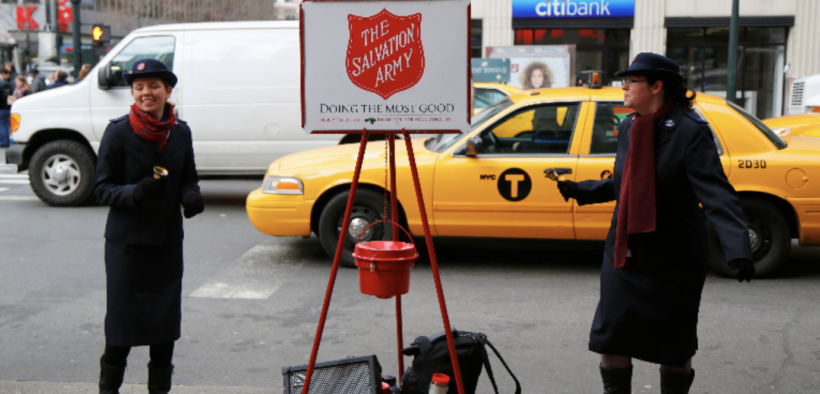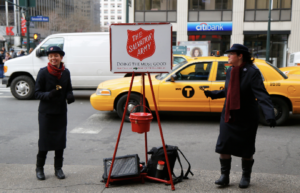Salvation Army Kettle Campaign Topped $102 Million

The Salvation Army’s 2022 Red Kettle fundraising campaign declined for the third year in a row this past holiday season, tallying just more than $102 million, a 19.1% falloff from the pre-pandemic high of $126.1 million reached during 2019. 
Donations during the Salvation Army’s signature fundraising drive have fallen 5.7% (2020), 8% (2021) and most recently 6.7% (2022) following the high-watermark year of 2019. The Red Kettle campaign, though amounting to just a fraction of what The Salvation Army takes in overall each year, still represents a vital source of funds—up to 20% or more in some cases—for the nonprofit’s more than 7,000 local affiliates and individual command posts across the United States.
The campaign consists almost entirely of in-person donations collected by bellringers at thousands of storefronts and other retail locations nationwide between Thanksgiving and Christmas Eve, most of which comes in the form of cash and coin contributions. There is also a relatively small amount (about 0.2%) of virtual, credit card and phone-tap transactions, said Dale Bannon, national community relations and development director for The Salvation Army.
The donations stay local and help pay for food, emergency shelter, rental and utility assistance, and other services to community residents in need throughout the year. The organization’s total revenue for fiscal 2021 was $5.795 billion.
“Celebrity partners, police and fire departments, high school volunteer groups, families, professional athletes, new bellringers, and longtime supporters of The Salvation Army all come together during the holiday season to support their communities at the Red Kettles,” Bannon said.
Leaders of The Salvation Army remain keen to accentuate the positive, citing the Red Kettle campaign’s staying power, even amid economic headwinds, as proof of a continued robust tradition of holiday giving. Still, the falloff in receipts has worried supporters who fear that more people shopping from home could further limit in-person foot traffic and giving opportunities at retail shopping centers and malls that have long been the campaign’s focal point. Bannon, however, told The NonProfit Times that the biggest culprit has been the falloff in volunteers that began during the pandemic.
Access to MinistryWatch content is free. However, we hope you will support our work with your prayers and financial gifts. To make a donation, click here.
“Ringing the bell requires personnel, and the primary reason for the decrease we’ve seen over the last couple of years has been the decline in volunteers,” Bannon said. “Prior to the pandemic, we were at over 2 million volunteers but then dropped to 1.3 million. We saw a little bit of a spike last year, to about 1.4 million. But, we are not unlike other nonprofit partners whose volunteer numbers are still at an all-time low. So, this upcoming year, we intend to do everything we can to encourage more volunteers.”
To offset the decline in holiday receipts, Salvation Army leaders last year launched a new “Love Beyond” campaign to encourage supporters to extend their generosity beyond the holiday season and consider giving all year long. A #GivingTuesday partnership with Sam’s Club, which matched the first $1 million in online donations received from Nov. 29 through Dec. 2, provided a further lift to fundraising efforts beyond the Red Kettle campaign.
“The first million was met within two days and helped ensure that thousands of families wouldn’t have to make difficult choices like paying their light bill or putting presents under the tree,” Bannon said.
Other highlights of last year’s campaign included a Red Kettle kickoff concert by the Jonas Brothers during the halftime show of the nationally televised Thanksgiving Day football game between the Dallas Cowboys and New York Giants. “Since beginning our partnership 26 years ago with the Dallas Cowboys, we’ve raised over $3 billion in those red buckets,” Bannon said. “We couldn’t do it without the Dallas Cowboys providing us that incredible platform and elevating the campaign every year on Thanksgiving Day.”
Other retail partners of the campaign included Albertsons Companies, Bass Pro Shops, Big Lots, Boscov’s, Cabela’s, Dillards, Food Lion, Hobby Lobby, JCPenney, Kroger, Macerich Shopping Centers, Mardel, Walgreens, and Walmart.
“Long-distance friends who travel more than 60 miles just to ring bells together, donors who are inspired to give back because they were once helped by The Salvation Army, and even unique volunteers like Hank the Horse step in to ring bells for The Salvation Army during Red Kettle season,” Bannon said. “The Red Kettle has been an iconic symbol of Christmas and of neighbors helping neighbors since 1891 and is probably the greatest equalizer in terms of giving opportunities, allowing everyone who comes to that red bucket and who rings that bell to experience the joy of what the giving season is all about.”
This article was originally published by The NonProfit Times.
The Salvation Army has four stars and a “C” transparency grade in the MinistryWatch database, and a donor confidence score of 59.



